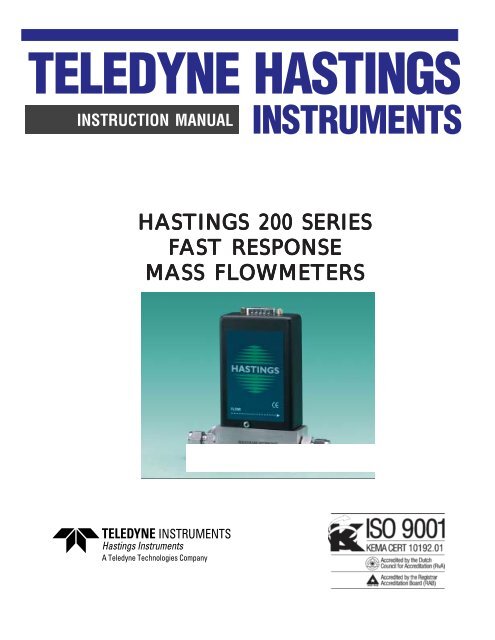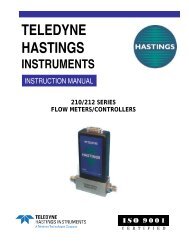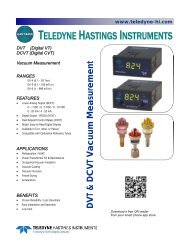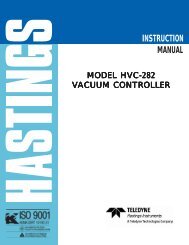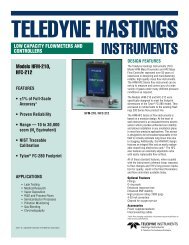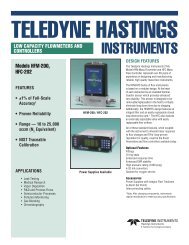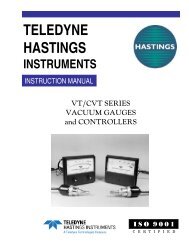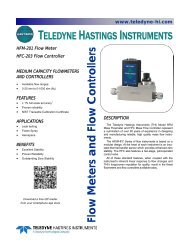HFM-229 - Teledyne Hastings Instruments
HFM-229 - Teledyne Hastings Instruments
HFM-229 - Teledyne Hastings Instruments
- No tags were found...
Create successful ePaper yourself
Turn your PDF publications into a flip-book with our unique Google optimized e-Paper software.
Manual Print HistoryThe print history shown below lists the printing dates of all revisions and addenda created for thismanual. The revision level letter increases alphabetically as the manual undergoes subsequentupdates. Addenda, which are released between revisions, contain important change information thatthe user should incorporate immediately into the manual. Addenda are numbered sequentially.When a new revision is created, all addenda associated with the previous revision of the manual areincorporated into the new revision of the manual. Each new revision includes a revised copy of thisprint history page.Revision B (Document Number 126-082000) ............................................................ August 2000Revision C (Document Number 126-082005) ............................................................ August 2005Visit www.teledyne-hi.com for WEEE disposal guidance.<strong>Hastings</strong> <strong>Instruments</strong> reserves the right to change or modify the design of its equipment withoutany obligation to provide notification of change or intent to change.126B - PAGE 2
1.3 Accessoriesies1.3.1 Power Supplies<strong>Hastings</strong>’ Power Supplies are designed as combination power supplies and digital readout monitors.They can simultaneously power a combination of different <strong>Hastings</strong> Flow <strong>Instruments</strong>. The front panel(9.47"H X 3.47"W) allows mounting of two units in a standard 19" rack. A terminal strip on the rearpanel provides the user with continuous analog outputs from all channels. All power supplies have a 3-1/2 LCD display.Models 200 and 400 Power Supplies can accommodate up to two or four <strong>Hastings</strong> Flow <strong>Instruments</strong>,respectively, and the Model 40 is for use with flowmeters only, powering up to 4 simultaneously. TheModel 40 also features user-adjustable gas conversion factors for direct reading when changinggases. For more information, request Product Bulletin No. 544.1.3.2 AlarmsThe Model AL-1 Flow Alarm is available as an attachment suitable for use with any 0-5.00 VDC inputsignal. Calibrated digital dial precision pots determine the low and high set points as a percent of fullscale. This permits use with any range flowmeter or other instrument having a 0-5.00 VDC linearoutput signal. Control action is within 0.2% of scale. The AL-1 is available in the panel mount Jpackage.1.3.3 TotalizerThe <strong>Hastings</strong> TR-1 Flow Totalizer integrates the 0-5.00 VDC signal generated by the flowmeter to givea total flow reading. Count rates from 0-999 counts per minute are selectable by internal setting. TheTR-1 is available in the panel mount J package.1.3.4 4-20 mA Current ConverterThe <strong>Hastings</strong> Model CC-420 Series Current Converter is an option available with <strong>Hastings</strong> MassFlowmeters. The CC-420 produces a 4-20 mA signal from the 0-5.00 VDC output of the flowmeter.The CC-420 is available in the panel mount J package.126B - PAGE 6
2.0 INSTALLATION AND OPERATIONThis section is designed to assist in getting a new flowmeter into operation as quickly and easily aspossible. Please read the following thoroughly before attempting to install the instrument.2.1 Receiving Inspection:Carefully unpack the <strong>Hastings</strong> Flowmeter and any accessories that arrive with it. Inspect it for anyobvious signs of damage due to shipment. Immediately advise the carrier who delivered the shipment ifany damage is suspected.Compare each component shipped against the packing list. Ensure that all parts are present (i.e.flowmeter, power supply, cables, etc.). Optional equipment or accessories will be listed separately on thepacking list (see Section 1.4 - Accessories). There may also be one or more OPT- options on thepacking list. These normally refer to special ranges or special gas calibrations. They may also refer tospecial helium leak tests or high pressure tests, or special modifications such as hightemperature or special O-ring materials. In most cases these are not separate parts, but rather specialoptions or modifications built into the flowmeter or power supply.2.2 Power Requirements:All <strong>HFM</strong> Model Flowmeters require ±15 VDC @ ±50 mA max . The 15 VDC can vary between 14.25VDC and 15.75 VDC. The supply voltage should be regulated with no more than 50 mV ripple. Surgesuppressers are recommended to prevent power line spikes from feeding through to the instruments.These power requirements are satisfied by the <strong>Hastings</strong> Power Supply described in Section 1.4 -Accessories.2.3 Output Voltage:The output of the flowmeter is a 0-5.00 VDC signal proportional to the flow rate. The output is sent tothe display and is available at terminals at the rear of the <strong>Hastings</strong> Power Supply. If a <strong>Hastings</strong> supplyis not being used, the output is available on pin 6 of the D connector. It is recommended that the loadresistance be no less than 2k Ohms.2.4 Mechanical Connections:The transducer may be oriented in any position, as long as the direction of gas flow through thetransducer follows the arrow marked on the bottom of the label. The preferred orientation is with theinlet and outlet fittings in a horizontal plane with the connector pointing up.The smallest passageway encountered on the <strong>Hastings</strong> <strong>HFM</strong> Flowmeter is .012" ID, therefore stepsshould be taken to ensure proper filtering thatprevents blockage of these passageways.There are two 8-32 threaded holes 1/4" deep inthe bottom of the transducer that can be used tosecure it to a mounting bracket, if desired.The standard inlet and outlet fittings for the<strong>HFM</strong>-<strong>229</strong> Flowmeter are 1/4" Swagelok. For the<strong>HFM</strong>-230, the fittings are 1/2"Swagelok. Optional VCR and VCO fittings areavailable from the factory. Viton O-rings arestandard with all fittings; Kalrez andNeoprene O-rings are optional and can beordered from the factory.Fig.2.1126B - PAGE 7
The standard inlet and outlet fittings for the <strong>HFM</strong>-<strong>229</strong>B Flowmeter are NPT thread in the size of thepipe listed on the drawing on page 22, for sizes up to 3" laminar. On the 4", 6", and 8" laminars, flangefittings are standard. Smooth tubulation is optional on all sizes.It is suggested that all connections be checked for leaks after installation. This can be done by pressurizingthe transducer (do not exceed 500 psig unless the transducer is specifically rated for higher pressures)and applying a diluted soap solution to the flow connections.2.5 Electrical Connections:If a power supply was purchased from <strong>Hastings</strong> <strong>Instruments</strong>, installation will consist of connecting thecable, purchased separately from the power supply, from the rear of the supply to the top of theflowmeter. If a <strong>Hastings</strong> supply was not purchased, follow the instructions below to connect up theflowmeter.The power supply used must be capable of supplying ±15VDC at ±50mA . These voltages must bereferenced to a common ground.Refer to Fig. 2.1. Connect -15VDC to pin 9 and +15VDC to pin 11. Pin 5 is common and must beconnected to the common connection at the power supply. Pin 7 is the case ground and it should beconnected to the cable shield if available, and to AC ground of the power supply. Pin 6 is the outputsignal from the flowmeter. This output will be 0-5VDC, 5VDC being 100% of rated or full flow.2.6 Operation:2.6.1 Power er Supply OperationDo not connect transducers while the power supply is energized. The display may read either percent offull scale or actual flow rate, depending on the power supply purchased. To read flow rate, turn displayswitch to desired channel.2.6.2 Ambient TemperaemperatureIn order to maintain the accuracy of the flowmeter with changes in ambient temperature, it is necessaryto keep the temperature of the transducer between 0 o C and 50 o C. Since some of the temperature shiftresults in a slight zero offset, better results are obtained if the flowmeter is re-zeroed at the operatingtemperature. The flowmeter calibration may change by a factor up to 0.1%/ o C. <strong>Hastings</strong> MassFlowmeters are for GAS flow, so DO NOT let the temperature and/or pressure of the gasreach a point that would cause the gas to change to a liquid state, or erroneous indications will result.2.6.3 Zero CheckTurn the power supply “ON”. Allow the flowmeter 10 minutes to warm up. Stop all flow through thetransducer and check electrical zero.CAUTION: Do not assume that all metering valves will completely shut off flow. Even a slight leakagethrough a valve will cause an indication on the meter which will falsely appear to be a zero shift.If necessary, adjust the “ZERO” potentiometer, located on the lower inlet side of the transducer, untilthe meter indicates zero. This zero should be checked periodically during normal operation.2.7 Range Changing:The range of the flowmeter can be changed in the field if recalibration facilities are available. Theinstructions to change the flow range can be found in Section 4.5. In order to change the range of aModel <strong>HFM</strong>-230 Flowmeter, a new laminar flow element must be purchased from the factory.126B - PAGE 8
For a constant power input, the differential thermocouple output is a function of the mass flow rate andthe heat capacity of the gas. Since the heat capacity of many gases is relatively constant over wideranges of temperature and pressure, the flowmeter may be calibrated directly in mass units for thosegases. Changes in gas composition usually only require application of a simple multiplier to the aircalibration to account for the difference in heat capacity, and thus the flowmeter is capable ofmeasuring a wide variety of gases.3.3 ElectronicsFig.3.4The Fast Response Model <strong>HFM</strong> uses a thermal flow sensor to measure flow through a capillary tube,which is a fixed percentage of the total flow through the instrument. This sensor develops an outputsignal proportional to flow which is approximately 0.8 mv full scale magnitude (see Figure 3.3). Thissignal is amplified by the meter circuitry until it is 0-5.00 VDC. This 5 volt output is sent back to thepower supply and to the flowmeter circuitry, if applicable. At the power supply the 5 volt output is sentto the terminals on the back and to the decoding circuitry in the display which converts it to a 3-1/2digit output.The Fast Response Model <strong>HFM</strong> uses additional electronics to achieve fast response characteristics byamplifying the rate ofchange of the input signal, and adding it to the amplified input signal. The electronicsare adjusted to provide response times of less than two seconds to 98% of a 0-100% step changewith less than 2% overshoot. The electronics also maintain the ouput signal above 5.00 VDC when theflowrate exceeds the full scale flow of the flowmeter.NOTE:The output signal will continue to increase above 5.00 VDC as the flow rate exceeds full scale flow,however, the output above 5.00 VDC is non-linear and should not be used for flow measurement.3.4 ShuntHigher measurement of flow rates is achieved by dividing the flow with a fixed ratio shunting arrangement,as is illustrated in Figure 3.4. This is accomplished by placing the measuring capillary tube parallelwith one or more dimensionally similarchannels, called a laminar flow element (LFE). Therefore, thesensor only needs to heat the gas passing through the capillary tube resulting in low power requirements,while retaining all the mass measuring characteristics.The <strong>HFM</strong>-<strong>229</strong> has two possible shunts. The low range shunt consists of tubes inserted into a cylindricalbase. This shunt is adjustable for ranges from 0-10 sccm to 0-250 sccm (see Figure 3.5). The higherrange shunt consists of a corrugated stainless steel ribbon wound into a coil and fused. The higher rangeshunt is adjustable from 0-0.3 slpm to 0-30 slpm ranges (Figure 3.6).Fig.3.5Fig.3.6126B - PAGE 10
The <strong>HFM</strong>-230 uses a shunt which is a corrugated and fused shunt similar to the shunt used in thelower flow range instruments (see Figure 3.7). This highest range shunt is adjustable from 0- 50 slpmto 0-500 slpm.The <strong>HFM</strong>-<strong>229</strong>B Series uses an external laminar flow element instead of an internal shunt, because thenecessary size for the element exceeds the body size of the flowmeter. This laminar flow element ismade of a corrugated and fused stainless steel ribbon similar to the one used in theModel <strong>HFM</strong>-230.Fig.3.7126B - PAGE 11
126B - PAGE 12
4.0 MAINTENANCE4.1 Introduction:This section contains service and calibration information. Some portions of the instrument are delicate.Use extreme care when servicing the flowmeter. The potentiometer positions and the electrical componentsreferred to in the troubleshooting section can be found in Section 6.0 on the electrical componentlayout drawing.4.2 Authorized Maintenance:With proper care in installation and use, the flowmeter will require little or no maintenance. If maintenancedoes become necessary, most of the instrument can be cleaned or repaired in the field. Someprocedures may require recalibration. Do not attempt these procedures unless facilities are available.Entry into the sensor or tampering with the printed circuit board will void warranty. Do not performrepairs on these assemblies while unit is still under warranty.4.3 Adjustments:4.3.1 Calibration Procedure1. Connect power cable to D connector as specified in Section 2.5. Allow instrument to warm up for30 minutes with all flow shut off.2. Set ZERO potentiometer for 0.000 VDC output at pin 6 on the D connector or flow output pin onthe rear of the <strong>Hastings</strong> Power Supply.3. Turn on air supply to inlet of instrument. Adjust flow rate to 100% according to flow reference.4. Adjust SPAN pot until the flowmeterindicates full scale flow (5.000 VDC).NOTE: Perform this step only if acalibrated reference flowmeter is available.5. Record flowmeter and flow referenceoutputs for flow rates of 20%, 40%, 60%,80%, and 100%.4.3.2 Response Time AdjustmentsReadjustments of the fast responsecircuit should not be necessary unlesschanges in the range or sensor havebeen performed. The flowmeter shouldbe calibrated before setting the responsetime.IMPORTANT: Response time cannotFig.4.1be tested with a simple shutoff valve.Pressure builds up behind the valve, and when opened creates a surge flow in excess of the calibrated flow rate.What must be used is a two-way valve or a fitting which can be quickly connected and provide a leak-free seal tothe flowmeter inlet. The reference flow is vented to atmosphere, and switches through the flowmeter when thevalve is operated or fitting is connected. The valve or fitting should be close coupled to the flowmeter inlet toreduce pneumatic time delays. The response pot is not accessible from the exterior of the flowmeter. The covermust be removed to make any adjustments. See Fig. 4.1.Using a voltmeter, strip chart recorder, or oscilloscope connected to the flow output voltage, switch flow throughthe flowmeter and observe output voltage. Adjust response pot to increase or decrease response time. Theresponse pot is a single turn pot and a small pot adjustment produces a large response time change. Remove flowfrom flowmeter and allow output voltage to reach zero volts. Repeat test until response time is set.4.3.3 Miscellaneous AdjustmentsPeriodically, during normal operation, the ZERO should be checked and adjusted when required.126B - PAGE 13
4.4 End Cap RemovalThe end cap on the inlet side must be removed to gain access to the filter or shunt assembly. First shutoff the supply of gas to the instrument. Disconnect the Swagelok fitting on the inlet and outlet sides ofthe instrument. Remove the four hex bolts holding the end cap to the instrument (see Figure 4.2).Carefully remove the end cap, filter, wave spring and shunt, noting their order and proper orientation.NOTE: The Model <strong>HFM</strong>-230 does not include a wave spring. The shunt can be severely damaged ifdropped. Examine the filter and shunt. If either is dirty or blocked, clean or replace as applicable.Reassembly is the reverse of the removal procedure.Fig.4.2NOTE: When reinstalling the small range shunt, ensure that corrugated side is down.4.5 Range ChangesRemove end cap and shunt assembly per Section 4.4 above. The 0-10 sccm to 0-300 sccm rangeshunt has tubes, while the medium range shunt is built from a coil of corrugated stainless steel foil. Themedium range shunt has a disk assembly with two large, one medium, and one small hole. To changeranges, the disc on the inlet of the shunt should be loosened, turned and retightened to expose thenumber of holes or tubes as listed below for the range desired.SIZE RANGESHUNT SETUPSMALL .......................................... 0-10 sccm ............................................................................... 0 tubes........................................................ 0-30 sccm ................................................................................ 1 tube........................................................ 0-50 sccm ............................................................................... 2 tubes........................................................ 0-100 sccm ............................................................................. 4 tubes........................................................ 0-250 sccm ........................................................................... 10 tubesMEDIUM ....................................... 0-.3 slpm ...................................................................... smallest hole........................................................ 0-1 slpm ........................................................................ medium hole........................................................ 0-3 slpm .......................................................... 1 large and small hole........................................................ 0-5 slpm ................................................................... both large holes........................................................ 0-10 slpm ........................................................................ half-washer........................................................ 0-30 slpm ................................................................. washer removedLARGE........................................... 0-50 slpm ................................................................................ 1 hole........................................................ 0-100 slpm ............................................................................. 2 holes........................................................ 0-150 ............................................................................... slpm3 holes........................................................ 0-300 ................................................................ slpmwasher removed........................................................ 0-500 ............................................................... slpm washer removedNOTETE: These ranges are for Air at Standard Temperature and Pressure.126B - PAGE 14
4.6 Printed Circuit BoardReplacementIn the unlikely event that the PC boardfails, it is easily removed from the instrumentand replaced with a spare to minimizeinstrument downtime. Replacement of thePC board will require the instrument to berecalibrated per Section 4.3.1.Unplug thepower cable from the top of the transducer.Remove the two screws on the side of thecover. Lift off the cover and unplug thefour-wire sensor plug noting the orientationprior to removal. Remove the screw thatholds the PC board to the sensor. Troubleshootor replace as applicable. Installation isthe reverse of the above procedure.Recalibrate if any components werechanged or if any potentiometers wereadjusted.Fig.4.34.7 Sensor ReplacementIf the sensor fails or becomes plugged it can be removed. Remove the cover and the PC board perSection 4.6 above. Remove the three bolts holding the sensor to the instrument base. Remove thesensor from the base noting the two O-rings (Parker 2-005, V884-75) between the sensor and the base.See Figure 4.3. If the sensor is plugged it can be cleaned by running a fine wire (approximately 0.008"diameter) through the tube. If sensor needs replacement, obtain another from the factory and install it.Ensure that O-rings are clean and intact. Install O-rings on seating surface, then carefully place sensorover O-rings, and tighten down the three screws evenly. Replacement of sensor will require recalibrationper Section 4.3.1.4.8 TroubleshootingSYMPTOM:Output reads 40% of flow with no flow. Zero pot has no effect.CAUSE:Power supply locked up or shorted out.ACTION:Turn off power supply for a few seconds, then turn back on. If this proves ineffective,disconnect the unit from the power supply. If power supply display does not return to zero, then aregulator chip in the power supply is probably burned out.Check supply voltages and replace faulty regulator. If displayreturns to zero after disconnecting the power supply from theunit there is a short in the unit to ground. Check capacitors C11& C13 first.SYMPTOM: Output of unit is proportional to flow butextremely small and not correctable by span pot.CAUSE: Sensor is not being heated.ACTION:Unplug sensor from PC board (Fig. 4.3). Pins on sensor arenumbered from left to right. Begin counting with second pin from left (see Fig.4.4). Check the resistance between pins 2 & 3 of the sensor. This will read between2450 & 2550. Check the resistance between pins 1 & 4 of the sensor. This shouldread approximately 2.3 ohms. If this reads open circuit, sensor was probablyplugged into PC board improperly and one of the thermocouples has beendestroyed. Replace sensor. Check the resistance between pin 2 and the base of thesensor. This should be an open circuit. Repeat for pin 3 and the base. If resistancereadings are correct but sensor is not indicating flow, the sensor is probably plugged;clean or replace as applicable.126B - PAGE 15Fig.4.4
SYMPTOM: Sensor has proper resistance readings, but little or no output with flow.CAUSE: Plugged sensor.ACTION:Shut off gas supply and power supply. Remove cover and PC board from unit. Removesensor assembly and examine. If sensor has evidence of plugging, clean or replace as applicable.SYMPTOM:Flowmeter reads other than 0.00 VDC with no flow, or there is a small flow whenflowmeter reads 0.00 VDC.CAUSE:ZERO potentiometer is out of adjustment.ACTION:Shut off all flow. Adjust ZERO potentiometer until output reads 0.00 VDC.SYMPTOM: Flowmeter out of calibration and non-linear.CAUSE:Leaks in gas inlet or outlet fittings.ACTION:Check all fittings for leaks by placing soap solution on all fittings between gas supply andfinal destination of gas. Check flowmeter for leaks. Replace “O” rings if required or recalibrate asnecessary.126B - PAGE 16
5.0 REPLACEMENT PARTSThe following is a list of the available replacement parts and their factory stock numbers. The <strong>HFM</strong>-<strong>229</strong>, <strong>HFM</strong>-<strong>229</strong>B, <strong>HFM</strong>-200, <strong>HFM</strong>-200B, and the HFC-202 shunts and filter discs are interchangeable.The <strong>HFM</strong>-230, <strong>HFM</strong>-201, and the HFC-203 shunts and filter discs are also interchangeable. Thesame sensor module is used on all of the above models.STOCK NO.DESCRIPTIONAIR RANGE81-102L......... LOW RANGE SHUNT .....................................................10, 30, 50, 100, 250 SCCM81-102H ........ MED RANGE SHUNT ....................................................... 0.3, 1, 3, 5, 10, 30 SLPM81-102B......... HIGH RANGE SHUNT ............................................... 50, 100, 150, 300, 500 SLPM65-140E......... LFE Model LS-2, 2.0" NPTM ................................................................. 0-750 SLPM65-140G ........ LFE Model LS-3, 3.0" NPTM ............................................................... 0-1500 SLPM65-140J .......... LFE Model LS-4F, 4.0" Flange ............................................................... 0-3000 SLPM65-140K ........ LFE Model LS-6F, 6.0" Flange ............................................................... 0-6000 SLPM65-140L......... LFE Model LS-8F, 8.0" Flange ............................................................ 0-15,000 SLPM39-02-003 ...... SMALL FILTER DISC ................................................. <strong>HFM</strong>-<strong>229</strong>, <strong>HFM</strong>-<strong>229</strong>B, ANDHFC-20239-02-002 ...... LARGE FILTER DISC ...................................................... <strong>HFM</strong>-230 AND HFC-20381-105 ........... SENSOR MODULE ........................................................................... ALL MODELS65-595 ........... FAST RESPONSE <strong>HFM</strong> ELECTRONICS CARD ...................... D CONNECTOR81-115 .....................................................................VITON O-RING KIT FOR <strong>HFM</strong>-200 and 200B81-116 ..................................................................................... VITON O-RING KIT FOR <strong>HFM</strong>-20181-146 .............................................................. KALREZ TM O-RING KIT FOR <strong>HFM</strong>-200 and 200B81-147 .............................................................................. KALREZ TM O-RING KIT FOR <strong>HFM</strong>-20181-150 ............................................................ NEOPRENE O-RING KIT FOR <strong>HFM</strong>-200 and 200B81-151 ............................................................................ NEOPRENE O-RING KIT FOR <strong>HFM</strong>-201NOTETE: Ranges listed are for same standard temperature and pressure.To place an order or to obtain information concerning replacement parts, contact the factory or ourlocal manufacturer’s representative in your area. See below, or this manual’s last page for the address orphone number. When ordering, include the following information:• Instrument model number• Part description• <strong>Hastings</strong> part number126B - PAGE 17
126B - PAGE 18
6.0 Warranty and RepairWararranty ranty Policolicy<strong>Hastings</strong> <strong>Instruments</strong> warrants this product for a period of one year from the date of shipment tobe free from defects in material and workmanship. This warranty does not apply to defects orfailures resulting from unauthorized modification, misuse or mishandling of the product. Thiswarranty does not apply to batteries or other expendable parts, nor to damage caused by leakingbatteries or any similar occurrence. This warranty does not apply to any instrument which has hada tamper seal removed or broken.This warranty is in lieu of all other warranties, expressed or implied, including any implied warrantyas to fitness for a particular use. <strong>Hastings</strong> <strong>Instruments</strong> shall not be liable for any indirect or consequentialdamages.<strong>Hastings</strong> <strong>Instruments</strong> will, at its option, repair, replace or refund the selling price of the product if<strong>Hastings</strong> <strong>Instruments</strong> determines, in good faith, that it is defective in materials or workmanshipduring the warranty period. Defective instruments should be returned to <strong>Hastings</strong> <strong>Instruments</strong>together with a written statement of the problem and a Return Material Authorization (RMA)number. Please consult the factory for your RMA number before returning any product for repair.Non-Wararranty ranty Repair PolicolicyAny product returned for a non-warranty repair must be accompanied by a purchase order, RMAform and a written description of the problem with the instrument. If the repair cost is higher, youwill be contacted for authorization before we proceed with any repairs. If you then choose not tohave the product repaired, a minimum will be charged to cover the processing and inspection.Please consult the factory for your RMA number before returning any product for repair.TELEDYNE HASTINGS804 NEWCOMBE AVENUEHAMPTON, VIRGINIA 23669 U.S.A.ATTENTION: REPAIR DEPARTMENTTELEPHONE (757) 723-65311-800-950-2468FAX (757) 723-3925126B - PAGE 19
126B - PAGE 20
7.0 Diagrams and Drawings126B - PAGE 21
PC-810 Assembly(Information from <strong>Hastings</strong> drawing 30837 rev. F)126B - PAGE 22
PC-810 Schematic(Information from <strong>Hastings</strong> drawing 30837 rev. F)126B - PAGE 23
126B - PAGE 24
126B - PAGE 25
126B - PAGE 26
126B - PAGE 27
126B - PAGE 28


